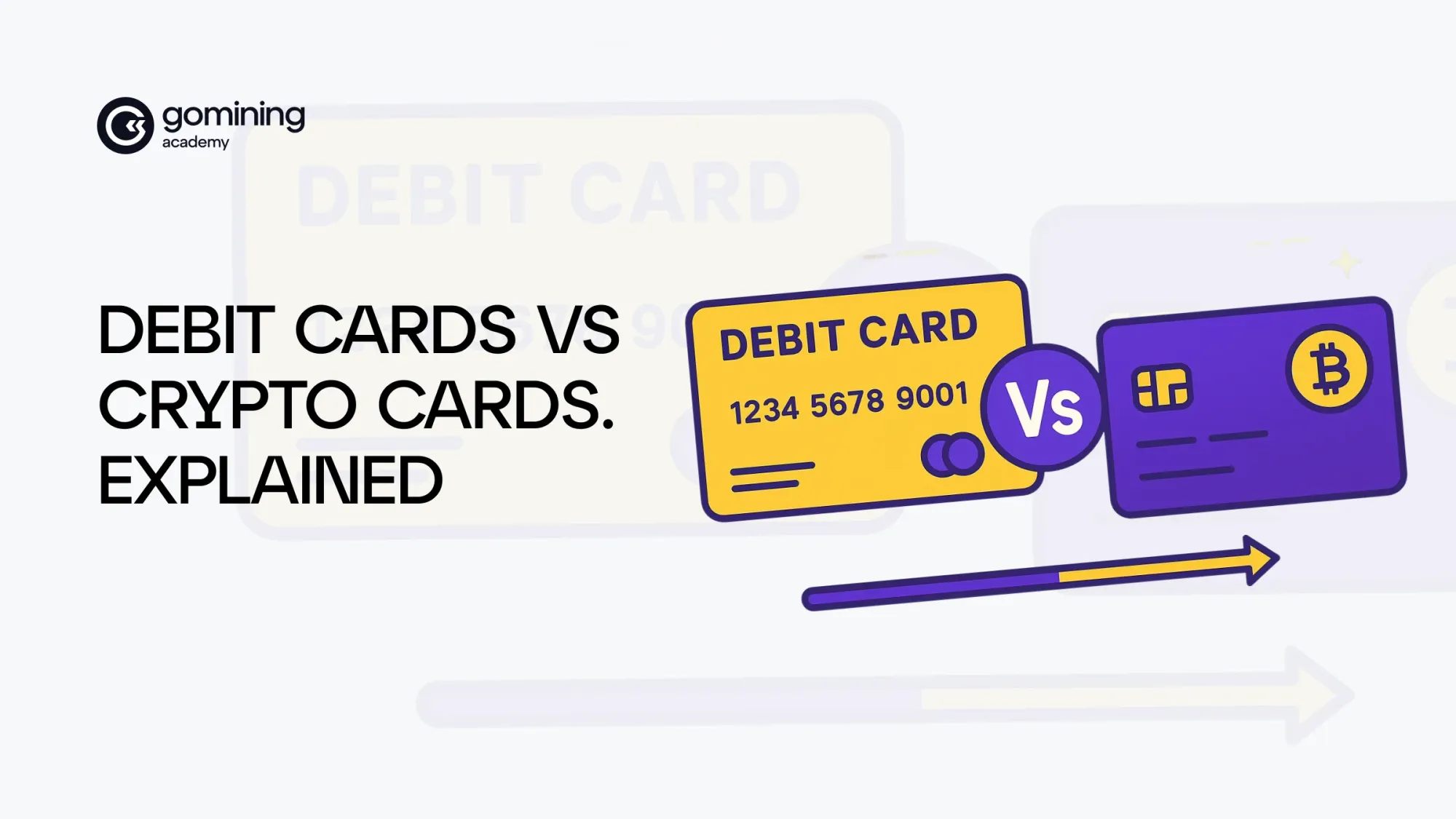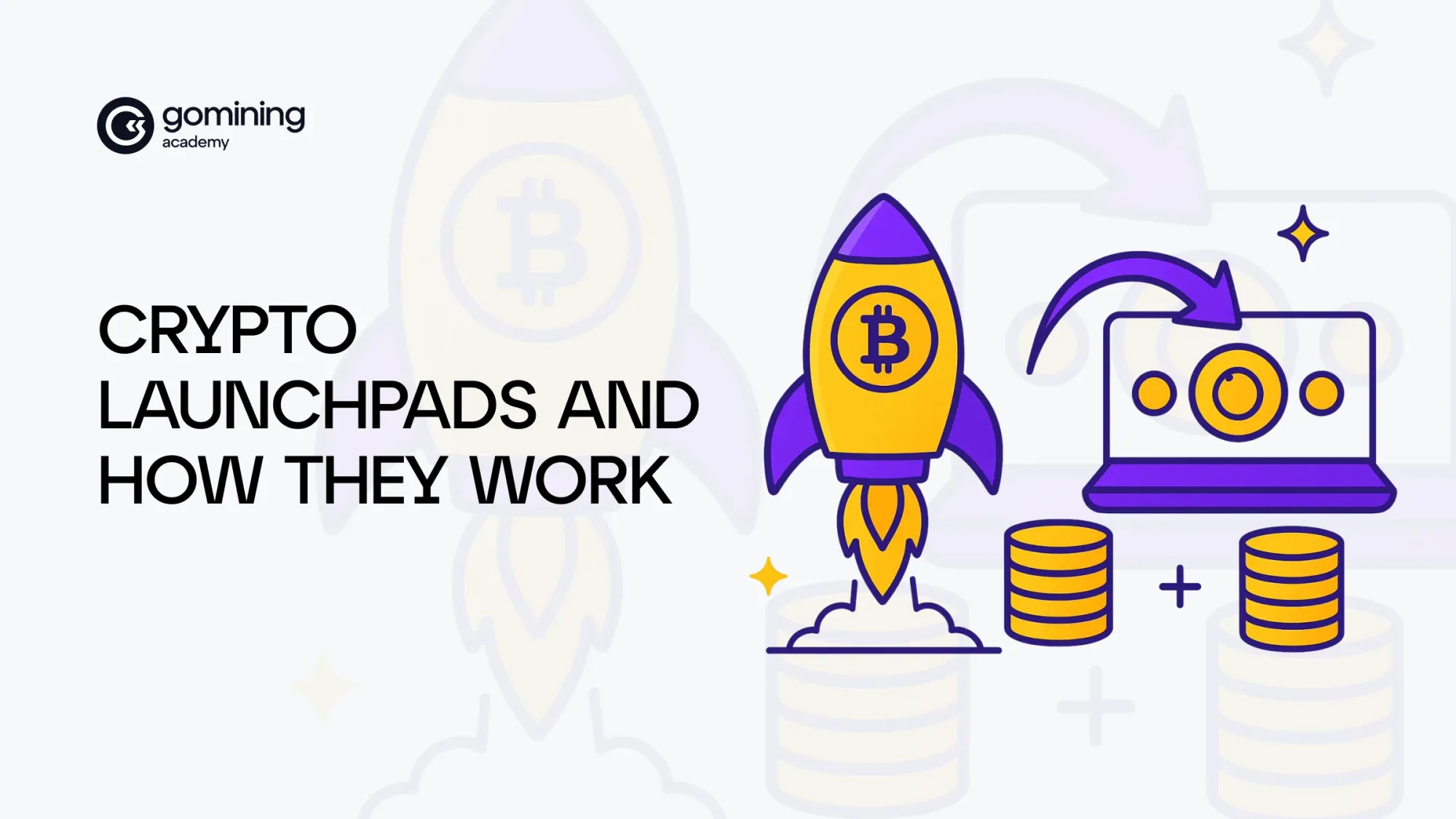How Do Bitcoin Transactions Work?
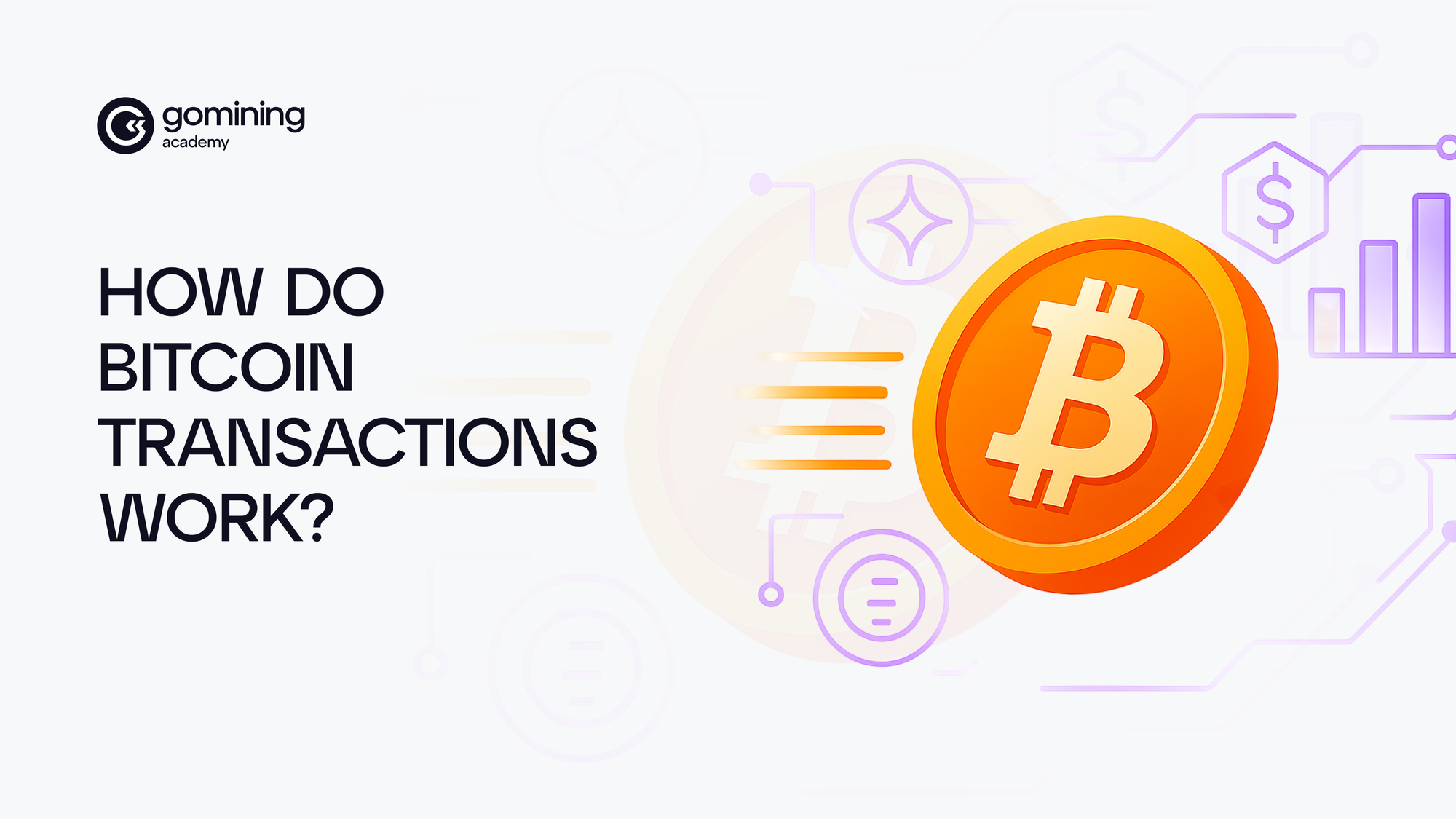
Ever wonder how Bitcoin moves around the globe without ever touching a bank?What looks like instant Internet money is actually a carefully choreographed process of digital signatures, public keys, and miner confirmations. Here’s how this decentralized dance keeps your BTC flowing safely.
Welcome to the fascinating world of Bitcoin transactions, where transferring money is as easy as sending an email—only far more secure, transparent, and revolutionary. From the digital wallets in your smartphone to the cryptographic keys safeguarding your virtual assets, Bitcoin transactions rewrite the rules of money transfers. But how does this digital magic actually happen?
Let’s dive in and decode exactly how Bitcoin moves, verifies, and secures value in a finance world that's quickly changing forever. By the end of this guide, you'll understand exactly how Bitcoin transactions move money securely without any banks involved.
Table of Contents
- The First Bitcoin Transaction
- Bitcoin Transactions: Step-By-Step
- Step1 : Crypto Wallet
- Step 2: Sending the Bitcoin
- Step 3: Spreading the Word
- Step 4: Miners Get to Work
- Final Step: How to Confirm Bitcoin Transaction
- From Checks to Chains: Checks vs Bitcoin Transactions
- The Bitcoin Transaction Journey: A Final Look
The First Bitcoin Transaction ✨
A Bitcoin transaction is basically a digital message that says, "Hey network, I want to move this amount of Bitcoin from here to there." It's not physical money—it's a secure digital record of who owns what.
The first Bitcoin transaction happened on 12 January 2009—just a week after the Bitcoin network went live—its creator, the still-mysterious Satoshi Nakamoto, sent 10 BTC to developer Hal Finney. Logged forever in block 170, this was the world’s first Bitcoin transaction.
Why does it matter?
- No middlemen: The coins zipped straight from Satoshi’s wallet to Hal’s—no bank, PayPal, or credit-card company in the middle.
- Open to everyone: Anyone can still see the transfer on the public blockchain; it’s as permanent as digital ink.
- Built-in safety: Hal shared a public address (like an email for money). Satoshi signed the payment with a private key (like a secret password). Miners confirmed the transaction, bundled it into a block, and—voilà—history was made.
With that single click, Bitcoin leapt from whitepaper theory to a working, peer-to-peer cash system. It proved you could move value across the internet as easily as sending an email—setting the stage for everything that followed.
Bitcoin Transactions: Step By Step
Imagine you've just bought some Bitcoin on a popular crypto exchange like Coinbase. And now you want to send 0.001 BTC to a friend.
Step 1: Crypto Wallet
Before you can send or receive Bitcoin, you need a crypto wallet. "Think of a crypto wallet as your personal interface to the Bitcoin network, much like an online banking app is your interface to the traditional financial system.
Crypto Wallets Come In All Shapes & Sizes
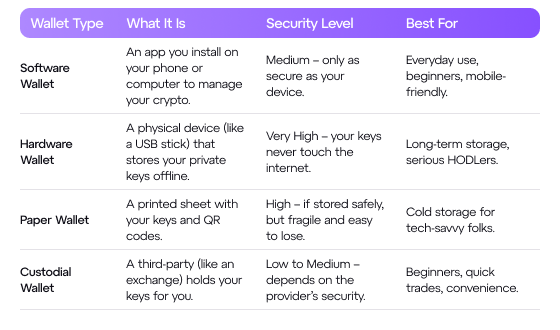
However, unlike a bank account, a Bitcoin wallet doesn't actually "store" your Bitcoins. Instead, it securely stores your cryptographic keys, which are the essential pieces of information that allow you to access and control your funds.
- A private key, your secret digital signature proving you're the owner of the wallet. Keep this one safe and hidden!
- A public key, which works like your email address, safe to share so others can send you Bitcoin.
- A Bitcoin address. This is a string of letters and numbers you provide to receive payments. It's cryptographically derived from your public key and is shorter and more user-friendly. To enhance privacy, a single wallet can generate and manage many different Bitcoin addresses.
⚠️ Losing your private key means losing your Bitcoin forever. There is no "forgot password" option in the world of decentralized finance.
⚠️ Beware of phishing attempts—if someone tricks you into sharing your key, they control your Bitcoin."
Step 2: Sending the Bitcoin
In your Bitcoin wallet, you simply enter your friend's Bitcoin Address—think of this like their bank account number—and the amount (0.001 BTC) you'd like to send.
Once you've entered your friend's Bitcoin Address and the amount, you simply hit the send button in your wallet. Instantly, your wallet uses your private key (like your secret password or signature) to digitally sign the transaction—confirming you truly own that Bitcoin and authorize the transfer. Once signed, your wallet broadcasts the transaction to the Bitcoin network, sending your Bitcoin securely on its way!
Bitcoin Transaction Fees?
Attached to your transaction is a small fee, like digital postage. This fee isn't for a bank; it's an incentive for the 'miners' on the network. The higher the fee you include, the more attractive your transaction is to these miners, the faster they will likely get it processed.
Your wallet usually suggests an appropriate fee based on how busy the network is. This is your Bitcoin transaction cost. You can track Bitcoin transaction fees online and how they vary with a Bitcoin transaction fee tracker.
Once your wallet signs off, it sends your transaction sailing across the Bitcoin network, safely toward your friend!
Inputs and Outputs: Bitcoin’s Built-In “Make Change” Trick
When you hit Send, your wallet doesn’t shave 0.001 BTC off a single balance the way a bank debits an account. Instead, it works more like handing over a bill and getting change back:
- Input – It’s simply a piece of Bitcoin you already own (tech people call it a “UTXO,” but you can think of it as cash coming out of your digital wallet).
- Outputs – the new “bills” your wallet creates:
- one for your friend (the payment)
- one for you (the change), minus the small miner fee
Quick example
You own one input worth 0.8 BTC.You send 0.3 BTC to a friend, with a 0.0002 BTC fee.Your wallet builds: – 1 input (0.8 BTC) – 2 outputs → 0.3 BTC to your friend, 0.4998 BTC back to you.The old 0.8 BTC is now spent; the two new outputs become the only spendable coins going forward.
By breaking and re-sealing “digital bills” every time, Bitcoin keeps clear ownership records without ever needing an account ledger—just a fresh set of outputs ready for the next transaction.
Step 3: Spreading the Word
Once your wallet broadcasts the transaction, it connects to other computers (called nodes) on the Bitcoin network and shares the transaction details. These nodes act like postal workers in a decentralized global mailroom—each one checks the package (your transaction) to make sure it’s valid and then forwards it to other nodes. Within seconds, your transaction is spreading like wildfire across the entire network.
But just because the message is out doesn’t mean it’s confirmed. Your transaction first enters a sort of digital waiting room called the mempool (short for memory pool). Think of it as a lobby where all unconfirmed transactions line up, waiting for a miner to pick them up and include them in the next block.
Every node has its own mempool, but they generally look similar. And miners, like chefs choosing ingredients, scan the mempool and prioritize which transactions to include—usually starting with those that pay the highest fees. Until a miner picks up your transaction and includes it in a block, it stays in this waiting zone, unconfirmed and in limbo.
Step 4: Miners Get to Work
So, your transaction is floating in the mempool—a digital waiting room filled with other valid, unconfirmed Bitcoin transactions. Now what?
This is where miners come in. Think of them as the decentralized accountants (or crypto cowboys 🤠) of the Bitcoin world. Their job? To collect a batch of pending transactions and bundle them into a new block. But before they can add that block to the official blockchain, they’ve got to win a race.
That race is called Proof-of-Work. It’s like a global guessing game where miners use powerful computers to solve a tough mathematical puzzle. The first miner to crack the code earns the right to add their block—along with your transaction—to the blockchain.
💰 What’s in it for them? A juicy reward: newly minted Bitcoin (known as the block reward) plus all the transaction fees from the block they just added. That’s why including a decent fee with your transaction helps—it gives miners a little nudge to pick yours over others waiting in line.
How to Track a Bitcoin Transaction (And Know If It Went Through)
So the coins have left the building… but where exactly are they now? Are Bitcoin transactions traceable?
Good news: Bitcoin doesn’t ghost you. Every transaction is trackable—like a pizza delivery with a public GPS.
Firstly: Grab Your Receipt — aka the TXID
After hitting “send,” your wallet gives you a Transaction ID (TXID). It’s a string of letters and numbers—basically your transaction’s license plate. Copy it like your crypto life depends on it.
Secondly: Pick Your Blockchain Spy Tool
Now head to a blockchain explorer, this will act as your Bitcoin transaction tracker. There are a few solid choices:
- Mempool.space – slick, real-time view
- Blockchain.com – beginner-friendly classic
- Blockstream.info – clean and nerdy (in a good way)
Paste your TXID into the search bar and voilà—your transaction appears in the spotlight.
Finally: See What’s Up
Here’s what you’ll find:
- Status: Is it still waiting? Already confirmed?
- Confirmations: Each new block added = one confirmation. You want six for max security.
- Where It’s Going: See which addresses were involved (no names, just wallet codes).
- Fee Paid: The “tip” you gave miners to process it faster.
💎 Bonus Tip: No TXID? No Problem
If you don’t have the TXID, some wallets still let you view recent transactions inside the app. And if your friend received it? Ask them to share the TXID from their end.
Final Step: How to Confirm Bitcoin Transaction
On average, a Bitcoin transaction gets its first confirmation in about 10 minutes—that’s how long it takes to add a new block to the blockchain. But for extra security, many wait for up to six confirmations, which takes roughly an hour. Once the transaction achieves the desired number of confirmations. it's deemed secure, and the recipient can confidently consider the funds as received.
💡 Already tracking your transaction? Your wallet will keep you posted on the number of confirmations, and if you’ve already checked it on a blockchain explorer like Mempool.space or Blockchain.com, you’re ahead of the game.
Faster Payments? Say Hello to Lightning
While regular Bitcoin transactions need to wait for confirmations, newer technologies like the Lightning Network are making things zippier. Think of Lightning Network as a fast lane for Bitcoin: it moves payments off-chain, allowing users to send tiny amounts instantly with barely-there fees. It’s not perfect for everything yet, but for everyday use—like buying coffee with crypto—it’s changing the game.
From Checks to Chains: Checks vs Bitcoin Transactions
Navigating the world of Bitcoin can feel like stepping into a sci-fi novel. So this article is going to bridge that gap between the familiar and the futuristic. Think of Bitcoin transactions as the digital evolution of writing a traditional check. By drawing parallels between these two methods, we can demystify the process and highlight how Bitcoin streamlines and secures transactions in our modern age.
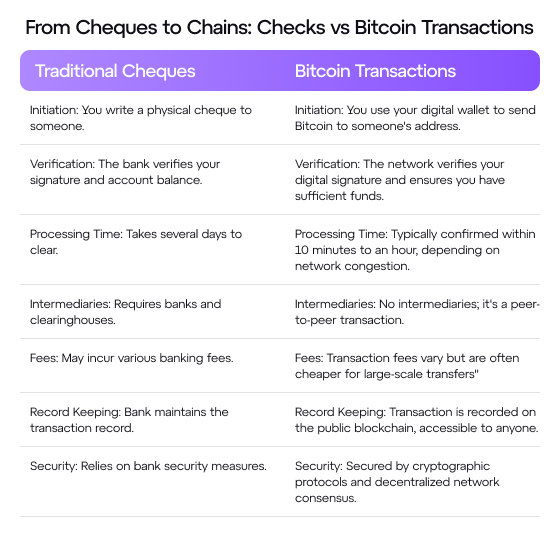
The Bitcoin Transaction Journey: A Final Look
From the days of penning checks to the era of digital wallets and blockchain confirmations, the evolution of financial transactions has been nothing short of revolutionary. Bitcoin technology stands at the forefront of this transformation, offering a decentralized, transparent, and efficient alternative to traditional banking methods.
In short, when you transact Bitcoins, you join a process that is open to everyone yet controlled by no single entity—just the cryptographic rules baked into the protocol.
In this article, we've walked you through how Bitcoin works. And examined how long do Bitcoin transactions take, where key factors such as heavy network traffic and a low-priority fee can delay confirmation from minutes to hours, whereas paying a slightly higher, competitive fee often secures a spot in the very next block.
Finally, we saw how to check Bitcoin transactions—paste the TXID into any public explorer, your Bitcoin transaction tracker, and you’ll see every detail: confirmations, fee paid, and the precise moment the network accepted your transfer.
Together, these pillars—mechanics, timing, cost, and transparency—form the backbone of a monetary system that has grown from one pioneering payment in 2009 to a borderless, round-the-clock financial network today.
Mining Rewards in Action — How Fresh BTC Joins the Transaction Flow
As you have read in this article every new block starts with the miner’s payday: the block reward plus fees are packaged into a single transaction and sent to a special address that only the miner can access and withdraw Bitcoin from. Miners do not only invest in their equipment, but invest in Bitcoin, by holding onto their earnings believing that their value will go up over time.
Bitcoin is increasingly being seen as a good investment, even entire sovereign countries look at Bitcoin and think about creating their own strategic Bitcoin reserve. Bitcoin mining is one way to get involved in the world of Bitcoin, and accumulate some Bitcoins yourself.
But being a Bitcoin miner is not smooth sailing. Especially dealing with all the headache and expense of managing a large warehouse in the middle of nowhere full of Bitcoin Mining machines. Not to mention how serious players in the industry are now using advanced Bitcoin AI mining to stay ahead of their competitors.
Don’t worry, GoMining can offers you passive income through Bitcoin mining, by tapping into hosted rigs from vetted GoMining hashpower providers.
Platforms that wrap real Bitcoin miners in NFTs make this easier to see up close. Each digital asset links to a verifiable machine, and daily payouts stream straight into the best Bitcoin mining app. Curious whether the numbers add up? Drop projected hash-power and electricity costs into the BTC mining calculator, then sanity-check the figures with the explainer in the article “Is Bitcoin mining profitable?”
Owning a miner token also unlocks extra yield layers familiar to DeFi users. Pay maintenance in the native digital token to shave fees, climb tiers in the GoMining VIP loyalty program, or share revenue through the GoMining referral program.
Prefer a gaming twist? Equip GoMining avatars—part of the wider GoMining collections—inside the on-chain Miner Wars mining game and watch every in-game power-up translate to bigger real-world payouts.
Want to compare business models? The deep dive Digital miner vs. cloud mining breaks down lock-ups, fees, and risk, while the project’s public crypto tokenomics page shows exactly how supply burns and reward pools stay balanced over time. Taken together, these links let you trace the entire lifecycle—from freshly mined BTC in a block reward to the moment those coins hit your wallet and join the normal flow of Bitcoin transactions you learned about earlier.

